Business Growth Through Integrated Sales and Marketing Operations
Key Takeaways
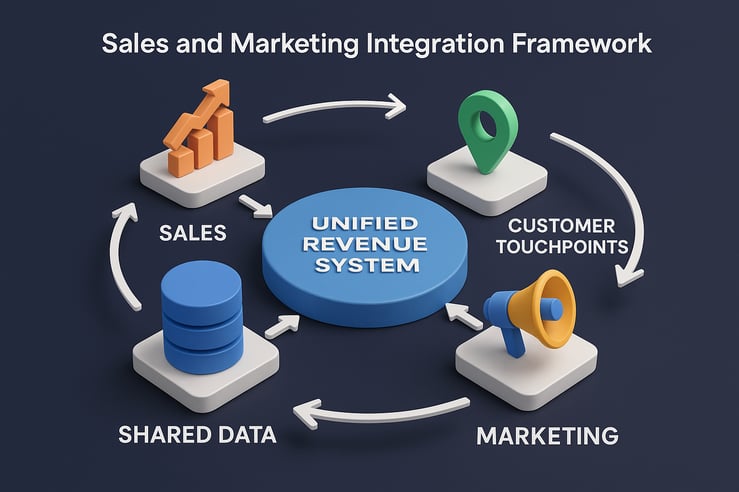
The strategic alignment of sales and marketing operations is crucial for sustainable business growth in today's competitive landscape. Here's what you need to know:
- Create cross-functional alignment: Breaking down departmental silos increases revenue by up to 38% while ensuring consistent messaging and improved customer experiences.
- Leverage data-driven decision making: Implementing analytics across the customer journey helps identify high-value opportunities and optimise campaign performance.
- Streamline operational workflows: Eliminating redundancies and refining processes reduces costs by 15-25% while improving pipeline management efficiency.
- Adopt integrated technology platforms, including CRM systems, marketing automation tools, and RevOps software, which bridge departmental gaps. Notably, 78% of high-performing teams cite technology as critical to their success.
- Monitor performance with key metrics: Track essential KPIs, including customer acquisition cost, conversion rates and customer lifetime value, to measure ROI and guide strategy refinement.
- Implement a unified RevOps framework: Companies with centralised Revenue Operations experience 19% faster growth and 15% higher profitability than those without.
- Foster collaborative team culture: Regular cross-departmental planning, shared goals, and transparent communication create a cohesive revenue-generating ecosystem.
Why Integrated Sales and Marketing Operations Drive Business Success
.jpeg?width=735&height=490&name=jpeg%20(7).jpeg)
In today's hypercompetitive business environment, sustainable growth requires more than just talented teams—it demands the strategic integration of sales and marketing operations. According to research by SiriusDecisions, organisations with tightly aligned sales and marketing functions achieve 24% faster revenue growth and 27% faster profit growth over three years compared to their less-aligned counterparts.
The traditional approach of operating these departments in isolation creates inefficiencies, mixed messaging, and missed revenue opportunities. Conversely, when sales and marketing unite around shared objectives and processes, businesses unlock significant advantages in operational efficiency, customer satisfaction, and sustainable profitability.
This comprehensive guide explores why integrated sales and marketing operations have become indispensable for modern business success and provides actionable strategies for achieving optimal alignment.
The Critical Importance of Sales and Marketing Alignment
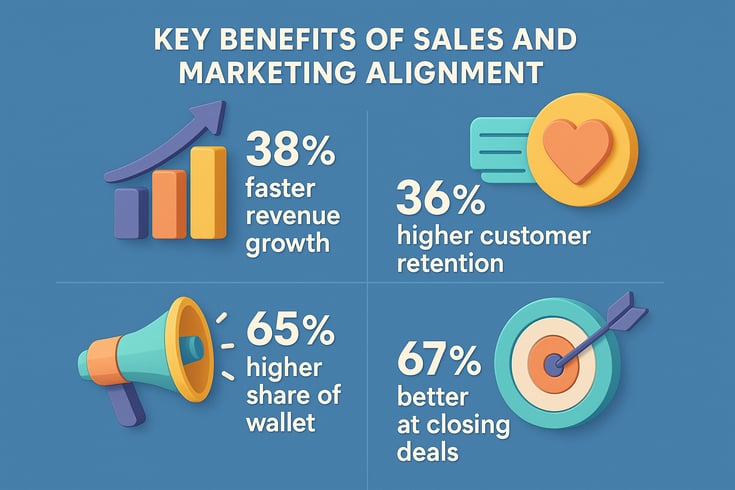
The True Cost of Departmental Silos
Disconnected sales and marketing departments create significant operational challenges that directly impact the bottom line:
- Information gaps: Marketing teams generate valuable buyer insights that sales teams often fail to access, while sales feedback often fails to reach marketing strategists.
- Resource wastage: According to Forrester Research, up to 70% of marketing content goes unused by sales teams due to poor communication.
- Customer experience inconsistencies: Disjointed messaging creates confusion and erodes trust throughout the buyer journey.
- Extended sales cycles: Without alignment, leads often require 36% more touchpoints before conversion.
These silos not only reduce departmental effectiveness but also create a fragmented customer experience that undermines conversion rates and loyalty.
Measurable Benefits of Strategic Alignment
When sales and marketing operations work in concert, organisations experience transformative benefits:
- Revenue acceleration: Companies with aligned teams achieve 38% higher sales win rates and 36% higher customer retention rates (MarketingProfs).
- Operational efficiency: Streamlined workflows eliminate duplicate efforts, with aligned teams reporting 27% faster revenue growth (LinkedIn).
- Enhanced lead quality: Collaborative feedback loops increase lead-to-opportunity conversion by up to 67% (Marketo).
- Shortened sales cycles: Aligned organisations report 36% shorter sales cycles on average (Sirius Decisions).
- Improved customer satisfaction: Consistent messaging across touchpoints increases customer satisfaction scores by an average of 38% (Aberdeen Group).
This alignment has evolved from a competitive advantage to a business necessity, particularly as customer expectations continue to rise and buying journeys become increasingly complex.
Strategic Frameworks for Integrating Sales and Marketing Operations

Implementing Shared KPIs and Objectives
The foundation of successful integration begins with unified performance metrics that drive collaborative behaviour:
- Revenue-based metrics: Joint accountability for pipeline generation, velocity, and closure rates
- Customer journey metrics: Shared responsibility for conversion rates at each funnel stage
- Efficiency metrics: Combined focus on customer acquisition costs and resource utilisation
According to Harvard Business Review, teams with shared KPIs are 2.4 times more likely to achieve high-performance outcomes.
Case Study: Software company Atlassian implemented shared OKRs (Objectives and Key Results) across sales and marketing, resulting in a 25% increase in qualified opportunities and 18% faster deal closure within six months.
Building Effective Cross-Functional Collaboration Systems
Regular structured interaction between teams creates the communication channels necessary for alignment:
- Weekly revenue operations meetings: Brief synchronisation sessions focusing on pipeline progress and upcoming campaigns
- Monthly strategic planning: Joint assessment of market trends, competitor moves, and performance against targets
- Quarterly business reviews: Comprehensive analysis of successes, challenges, and strategic adjustments
Example Framework: Implement a "smarketing" calendar that schedules regular touchpoints:
- Weekly 30-minute pipeline reviews
- Bi-weekly campaign planning sessions
- Monthly feedback forums between sales representatives and marketing teams
- Quarterly strategic alignment workshops
The Revenue Operations (RevOps) Model
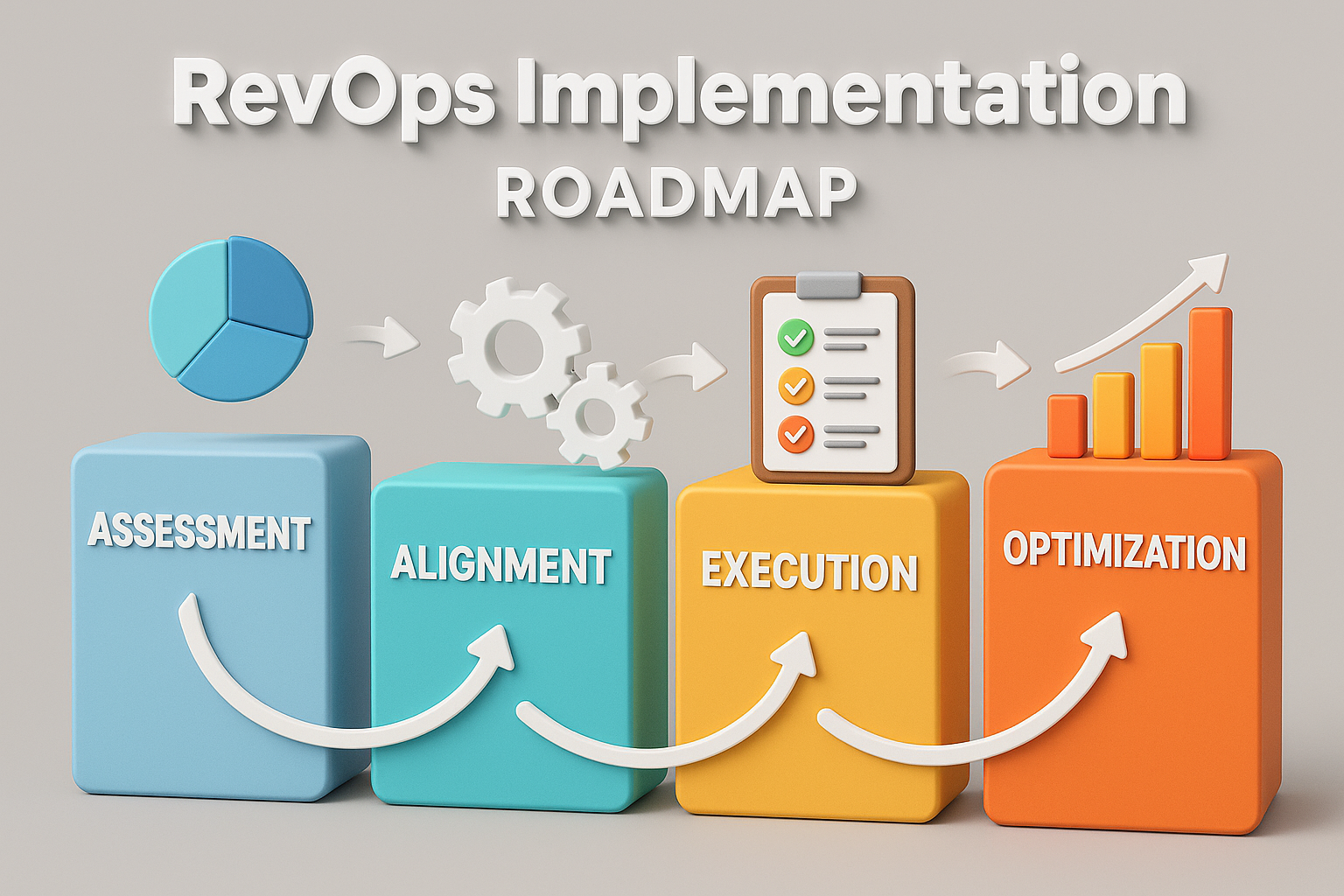
RevOps represents the evolution of sales and marketing alignment, creating a unified operational structure that eliminates functional silos:
- Centralised data management: Creates a single source of truth for customer information
- Standardised processes: Establishes consistent workflows across the entire revenue generation cycle
- Unified technology stack: Ensures seamless information flow between platforms and teams
- Integrated reporting: Provides comprehensive visibility into the entire customer journey
According to Boston Consulting Group, companies implementing RevOps frameworks experience 19% faster growth and 15% higher profitability than those maintaining traditional departmental structures.
Technology Enablers for Sales and Marketing Integration
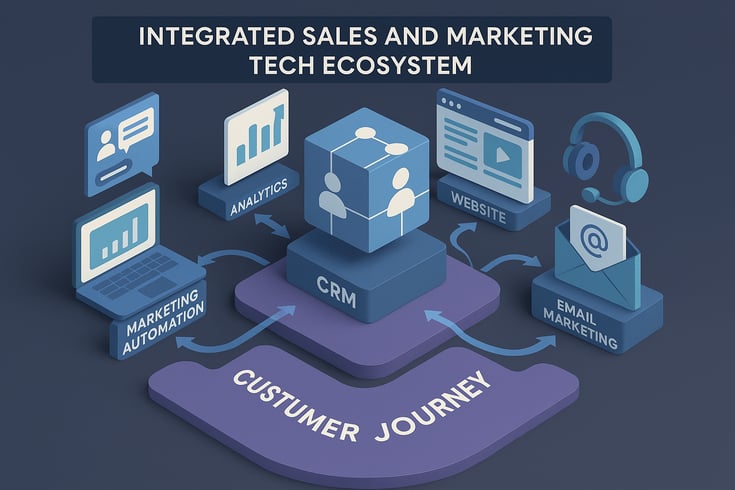
The right technology stack serves as the infrastructure supporting seamless operations between teams:
Essential Platforms for Operational Alignment
- Customer Relationship Management (CRM) Systems: Platforms like Salesforce, Microsoft Dynamics and HubSpot CRM create unified customer views, with 91% of businesses with more than 11 employees now using CRM systems.
- Marketing Automation Platforms: Tools such as HubSpot, Marketo and Pardot enable scaled personalisation and lead nurturing, with automation increasing qualified leads by an average of 451% (Annuitas Group).
- Sales Enablement Tools: Solutions like Highspot, Seismic and Showpad ensure consistent messaging and content delivery, improving sales productivity by up to 40%.
- Revenue Intelligence Platforms: Gong, Chorus and Clari provide AI-powered conversation and pipeline analytics, helping teams identify winning patterns and risk factors.
Data Integration and Analytics Capabilities
Effective alignment requires seamless data flow between systems:
- Customer Data Platforms (CDPs): Create unified customer profiles from multiple data sources
- Business Intelligence Tools: Transform raw data into actionable insights through visualisation
- Predictive Analytics: Leverage AI to identify high-potential opportunities and optimise resource allocation
According to Forrester, companies that implement integrated data systems report 45% higher team productivity and 36% higher customer satisfaction scores.
Automation for Process Optimisation
Automation streamlines repetitive tasks and ensures consistent execution:
- Lead scoring and routing: Automatically qualify and assign leads based on behaviour signals
- Content personalisation: Dynamically adjust messaging based on prospect attributes and actions
- Performance reporting: Generate real-time dashboards showing progress against shared KPIs
Real-World Example: Financial services firm Prudential implemented an integrated marketing and sales automation platform, resulting in a 15% increase in qualified leads and a 24% reduction in customer acquisition costs within the first year.
Measuring Success and Scaling Operations
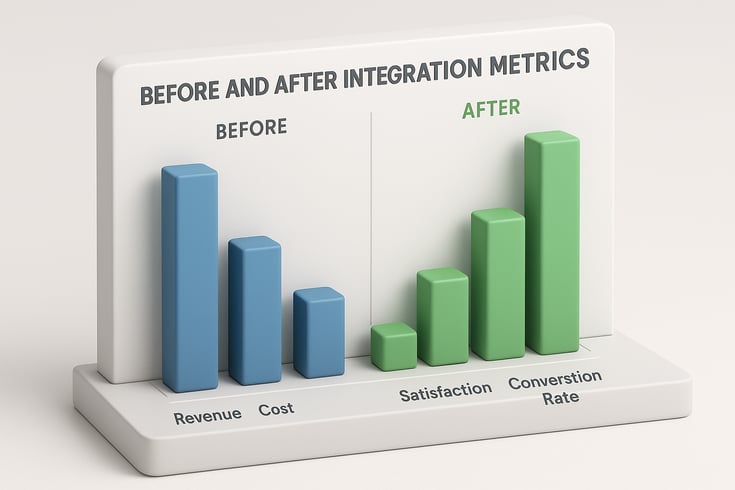
Critical Metrics for Evaluating Alignment
Tracking the right performance indicators ensures continuous improvement:
Lead-to-Revenue Metrics:
- MQL to SQL conversion rate (benchmark: 20-30%)
- SQL to closed deal conversion rate (benchmark: 15-25%)
- Average deal cycle time (industry-specific)
Efficiency Metrics:
- Customer Acquisition Cost (CAC)
- CAC:LTV ratio (benchmark: 1:3 or better)
- Marketing ROI (benchmark: 5:1 or higher)
Collaboration Metrics:
- SLA compliance rates
- Cross-team satisfaction scores
- Content usage rates by sales teams
Scaling for Sustainable Growth
As organisations expand, maintaining alignment requires structured approaches:
- Documented playbooks: Create detailed guides for processes, handoffs and collaboration
- Continuous training: Invest in ongoing skill development as tools and techniques evolve
- Growth-stage adjustments: Modify frameworks as the organisation expands into new markets or segments
Case Study: HubSpot scaled its integrated operations model from 50 to 500+ employees by implementing tiered SLAs, regular cross-functional training, and modular technology architecture that expanded with business growth.
Implementation Roadmap for Integrated Operations
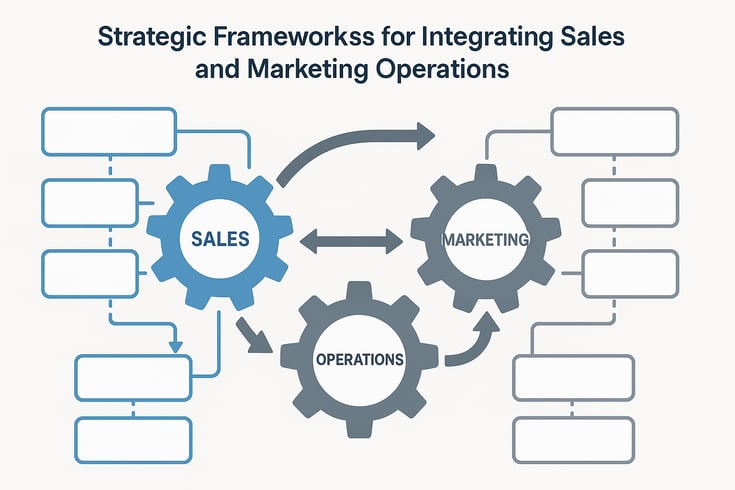
Assessment and Planning Phase
1. Current State Analysis:
- Audit existing workflows, handoffs and pain points
- Identify technology gaps and integration opportunities
- Measure baseline performance metrics
2. Strategic Alignment:
- Define shared objectives and key results
- Establish common definitions for lead stages and qualifications
- Create service level agreements between departments
Execution Phase
3. Organisational Structure Adjustments:
- Consider implementing a RevOps function
- Define clear roles and responsibilities
- Establish cross-functional team leaders
4. Technology Implementation:
- Select integrated platforms that support collaboration
- Configure data sharing and visibility settings
- Implement automation for routine processes
5. Process Optimisation:
- Document standardised workflows
- Create feedback mechanisms
- Establish regular review and improvement cycles
Optimisation and Scale Phase
6. Performance Monitoring:
- Implement dashboards tracking joint KPIs
- Conduct regular progress reviews
- Adjust strategies based on data insights
7. Continuous Improvement:
- Schedule quarterly strategic alignment sessions
- Collect team feedback on collaboration effectiveness
- Invest in ongoing training as technologies evolve
Frequently Asked Questions About Sales and Marketing Integration
![]()
What is the difference between sales operations and marketing operations?
Sales operations focuses on optimising the sales function through process improvement, technology management, and performance analysis to increase sales efficiency and effectiveness. This includes managing CRM systems, sales forecasting, territory planning, and commission structures.
Marketing operations concentrates on campaign execution, marketing technology, performance measurement, and budget management to maximise marketing ROI. This encompasses marketing automation, attribution modelling, content management systems, and campaign analytics.
While distinct in focus, these functions achieve maximum impact when strategically aligned around shared business objectives.
How do you measure the ROI of integrating sales and marketing operations?
Measuring ROI requires tracking both financial and operational metrics:
- Revenue impact: Compare growth rates before and after integration
- Cost efficiency: Calculate savings from eliminated redundancies
- Process improvements: Measure reductions in lead response time and sales cycle length
- Conversion enhancements: Track improvements in stage-by-stage conversion rates
A comprehensive ROI assessment should include both short-term gains (usually operational efficiencies) and long-term benefits (typically revenue growth and customer retention improvements).
What are the most common challenges when integrating sales and marketing teams?
Common integration challenges include:
- Cultural differences: Sales often has a short-term, transactional focus while marketing tends toward longer-term, relationship-building perspectives
- Technology fragmentation: Disconnected systems create data silos and hinder collaboration
- Metric misalignment: Teams measured on different success criteria may optimise for conflicting outcomes
- Process gaps: Unclear handoff procedures lead to leads falling through cracks
- Change resistance: Established teams may resist new workflows and shared accountability
Successful integration addresses these challenges through clear leadership, change management strategies, and incremental implementation approaches.
How has AI impacted sales and marketing operations integration?
AI has revolutionised integrated operations in several key ways:
- Predictive lead scoring: Machine learning algorithms identify the most promising prospects based on behavioural and demographic signals
- Customer journey analysis: AI identifies patterns in successful customer journeys to optimise touchpoints
- Content personalisation: Dynamic content delivery based on individual prospect profiles and behaviours
- Conversation intelligence: Analysis of sales conversations to identify effective messaging and objection handling
- Resource allocation: AI-driven recommendations for optimal marketing spend and sales effort distribution
According to McKinsey, companies implementing AI in sales and marketing functions report revenue increases of 3-15% and cost reductions of 10-20%.
What role does customer success play in integrated operations?
Customer success has emerged as the third critical component of truly integrated revenue operations:
- Feedback loop creation: Customer success teams provide valuable insights on product usage and satisfaction that inform marketing messaging and sales approaches
- Expansion revenue generation: Coordinated handoffs from sales to customer success enable effective cross-selling and upselling
- Retention improvement: Aligned operations ensure consistent customer experiences from prospect to long-term client
- Advocacy development: Satisfied customers become valuable references and testimonials for marketing and sales efforts
According to Bain & Company, increasing customer retention by just 5% can increase profits by 25-95%, making customer success an essential partner to sales and marketing.
Conclusion: The Future of Integrated Sales and Marketing Operations

The integration of sales and marketing operations has evolved from an aspirational goal to a business imperative for companies seeking sustainable growth. As customer expectations continue to rise and buying journeys become increasingly complex, the ability to deliver seamless experiences across all touchpoints will separate market leaders from laggards.
Technology will continue driving this evolution, with AI and machine learning enabling ever more sophisticated alignment of messaging, timing, and channel selection. Meanwhile, the rise of Revenue Operations as an organisational framework signals a structural shift toward truly unified go-to-market strategies.
Ultimately, the most successful organisations will be those that view sales and marketing not as separate functions but as interconnected components of a comprehensive revenue generation system. By breaking down silos, aligning metrics, leveraging technology, and fostering collaborative cultures, businesses can create sustainable competitive advantages in their pursuit of growth.
The future belongs to integrated operations—where data flows freely, insights drive action, and the entire organisation aligns around delivering exceptional customer experiences that drive revenue growth.

